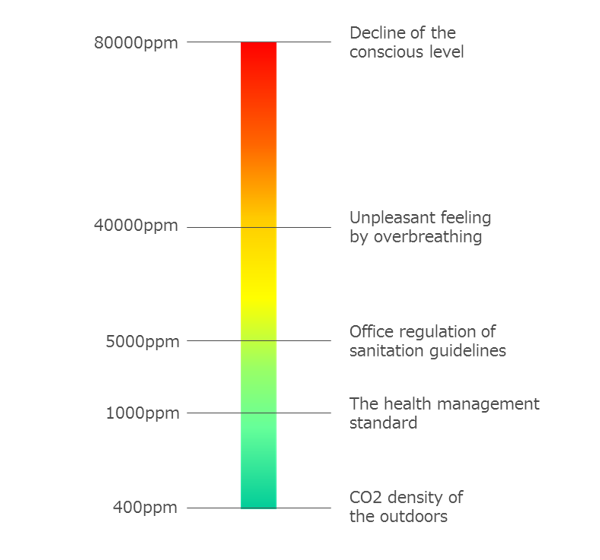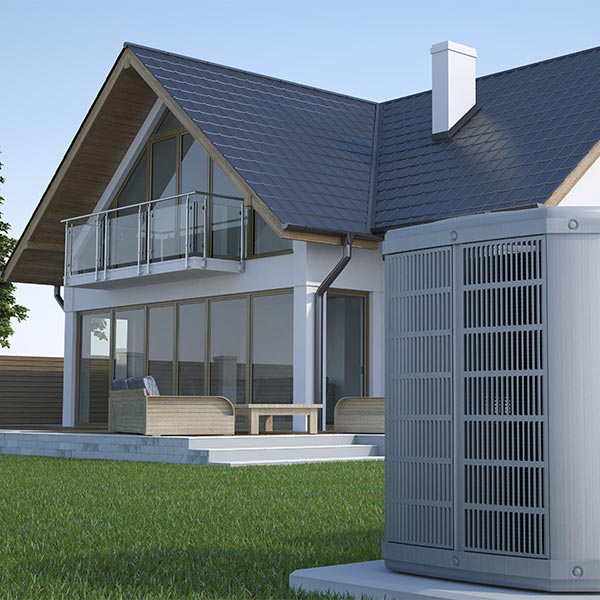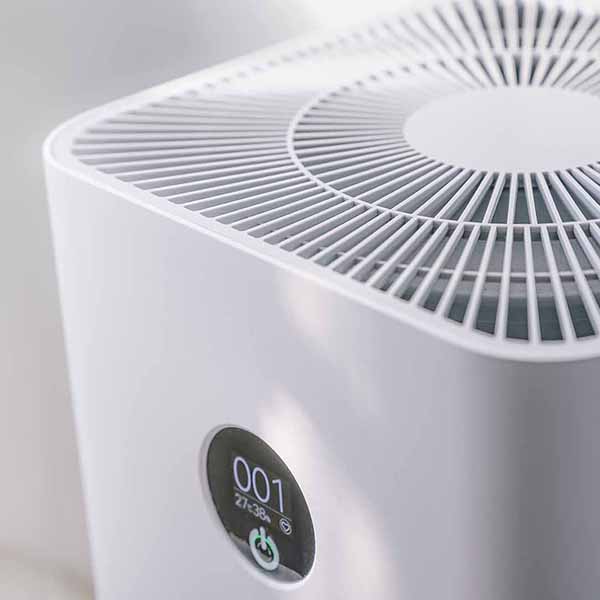Maintaining air quality while conserving energy
Indoor Air Quality (IAQ) by CO2 Monitoring
Air quality can be controlled by measuring CO2 levels.
This saves energy while maintaining a healthy indoor environment.
CO2 Sensors
We spend most of our time indoors, at home or in classrooms, offices, or stores. The greater the number of people in a room, the more CO2 there will be in the air. Inadequate ventilation results in poor air quality. This is not only hazardous to one's health, but also affects productivity and decision-making. For this reason, room air quality and ventilation are important.
However, over-ventilation is expensive and consumes more air conditioner energy than necessary. It is important to find the optimal balance between one's health, which is affected by poor air quality, and the cost of ventilation. To do this, the concentration of CO2 in indoor environments must be measured as an indicator of air quality, and this data must be used to optimize the operation of air conditioner ventilation systems.
What happens to us if we do not use ventilation?
Guidelines for indoor air quality and CO2 concentration standards have been established around the world.
For example, in Japan, the Ministry of Health, Labor and Welfare's health management standards for buildings stipulate that CO2 concentrations should be kept below 1000 ppm. When this concentration is exceeded, it causes discomfort. If the concentration rises further still, it will cause blood oxygen levels to fall, causing various physical issues such as drowsiness, headaches, and fatigue. It also causes declines in work and study productivity. High CO2 levels also affect sleep.
The following studies have been published on the effects of CO2 on the human body.
Low indoor CO2 concentrations of 500 to 800ppm are considered to harmless. However, as CO2 levels rise, they cause drowsiness and affect cognitive abilities, such as impairing learning and decision-making ability. At levels of 80,000 ppm or higher, people lose consciousness and eventually die.

Studies regarding decision-making ability
CO2 concentrations of 1500ppm to 3000ppm have been observed to negatively affect human performance and health.
#1 1500 ppm and above: Scores worsened in tests of decision-making ability
#2 2500 ppm and above: Test passing rates fell
#3 2500 ppm and above: Scores declined in tests measuring decision-making ability
#4 3000 ppm and above: Changes in specific frequency components of cardiac cycle variations correlated with autonomic nerve balance
(#1 Harvard T.H. Chan School of Public Health, January 2016)
(#2 Harvard T.H. Chan School of Public Health, January 2018)
(#3 State University of New York, December 2012)
(#4 Budapest University of Technology and Economics, March 2012)
 Relationship between CO2 concentration and activity
Relationship between CO2 concentration and activity
Studies regarding the relationship between CO2 concentration and drowsiness/sleep
Studies show that drowsiness increases at CO2 concentrations of 2500ppm and above and sleep quality decreases at concentrations of 1500ppm and above.
#1 1500 ppm and above: Decreased subjective sleep efficiency
#2 1700 ppm and above: Decreased subjective sleep quality
#3 2500 ppm and above: Increased subjective drowsiness
#4 2700 ppm and above: EEG showing increase in brainwaves indicating drowsiness
#5 3,500 ppm: Increased subjective drowsiness *Verified through actual vehicle driving
(#1 Waseda University, September 2018)
(#2 Technical University of Denmark, October 2014)
(#3 Tampere University of Technology, January 2016)
(#4 University of Southampton, November 2018)
(#5 Taipei Medical University, January 2020)
 Air quality and conserving energy in the office
Air quality and conserving energy in the office
The main source of CO2 inside buildings is the exhalation of the people inside them. Typically, CO2 concentrations range from 400 to 2,500 ppm. The greater the number of people, the greater the CO2 concentration. Opening windows is, of course, important, but it is also recommended to use ventilation control systems.
CO2 sensors measure the amount of CO2 in the air and send a signal to a ventilation device or variable air volume system (VAV). They then control individual fan damper valves to adjust ventilation levels. Of course, air is not composed of CO2 alone. Ventilating rooms also reduces the number of viruses and bacteria, improved indoor air quality.
Europe and the U.S. are at the forefront of residential energy savings through their use of highly airtight, highly insulated homes. They have established various regulations and targets for ZEHs (Net Zero Energy Houses). These regulations mandate strict insulation requirements for new homes. The United States set a target of making all new homes ZEHs by 2020. The EU has established legal regulations for member states with the aim of making all new residences ZEHs by 2020.
Highly airtight and highly insulated houses retain heat well, which improves the efficiency of their heating and cooling equipment. It also makes it possible to cut energy consumption while maintaining a comfortable indoor environment. However, the more airtight a room is, the poorer its ventilation is, and the more likely the air in the room is to become dirty. This results in a decline in the quality of the air. Without ventilation, the indoor environment will worsen. CO2 levels will rise, there will be chemicals and mites suspended in the air, and there will be a greater likelihood of molding. The advance of the ZEH movement is creating a growing need for proper ventilation.
Demand for heating and cooling changes depending on the season, and the number of visitors to commercial buildings such as office buildings, classrooms, and movie theaters varies greatly from day to day. Ventilating rooms assuming maximum room occupancy wastes energy when the rooms are empty.
Therefore, CO2 sensors can be used to estimate the amount of fresh air required based on the conditions in individual rooms and control ventilation accordingly.
AKM has confirmed that our CO2 sensors are effective in understanding and improving air quality through tests in actual restaurants and houses.
How much energy does ventilation use?
Among the 13 countries participating in the International Energy Agency's (IEA) energy-saving program for buildings and regional systems, the total primary energy consumed by building ventilation was estimated to be equivalent to 9% of each country's total primary energy consumption.
Each year, an estimated 3 exa-joules (EJ: 10^18 joules) of energy are used in the ventilation of US homes. This accounts for roughly 30% of the total energy used by these buildings. In the U.S. service industry (buildings such as commercial facilities, agencies, and government agencies), an estimated 1.5 EJ is used for ventilation. This accounts for roughly one-quarter of the total energy consumed by buildings in the service industry. In addition, ventilation accounts for approximately 1,000 tons of carbon dioxide emissions each year in the U.S. housing sector and 800 million tons each year in the service sector.
The energy required to regulate ventilation temperatures is greatly affected by the climate. In Europe, most of ventilation temperature control energy is used for heating. In the United States, considerable energy is used for both heating and cooling. In the humid Miami climate, 86% of this energy is used to dehumidify ventilation air. It is vital to consider how these energy expenditures can be reduced in order to protect the global environment.

Where should sensors be placed in rooms?

The locations where CO2 measurement sensors should be installed depend on the size of the room. In large areas such as restaurants and lobbies, it is logical to install them in ventilation systems to detect the CO2 levels of exhaust. If a sensor is installed on one wall, it could lead to incorrect assumptions about the CO2 levels on the opposite side of the room. In a typically sized room, the use of a wall-mounted sensor is sufficient.
CO2 level and temperature distributions differ. Temperatures are uniform throughout rooms. CO2 concentrations, on the other hand, can vary from 3,000 ppm on one side a room to 600 ppm on the other side.
Be careful regarding CO2 concentration when using air purifiers, as well.
When all the windows and doors of a room are closed, even if an air purifier is used to remove all contaminants from the air, CO2 levels can rise to dangerous levels. Forthright air purifier manufacturers inform customers of this. For optimal air quality, we recommend that air purifiers be used together with CO2 sensors.

Examples of CO2 sensors used to measure indoor air quality

The need for countermeasures against the spread of diseases such as COVID-19 have made ventilation an important keyword. Various manufacturers have begun selling CO2 sensor devices for accurately measuring indoor CO2 levels. We would like to introduce some of the devices in which our own sensors are used.
Customer stories











